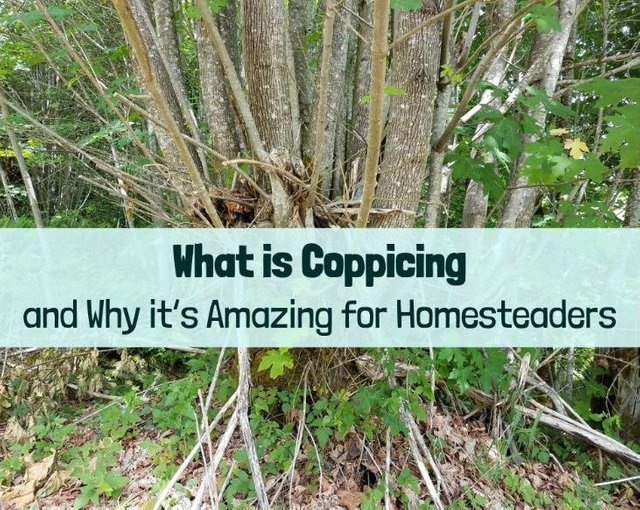What is Coppicing - Quick Intro

Are you familiar with coppicing? What about pollarding? Both of these ancient methods are amazing for managing the woodlands on your homestead. If you don't really know what these terms mean then this weeks blog post - What is Coppicing? (And Why It’s Amazing for Homesteaders) - is a great place to start.
This post is a fairly short post that focuses on getting you started by explaining what coppicing is and how it differs from pollarding. The post also dives into why coppicing is amazing for your homestead.
Do you use coppicing to manage your woodlands? What about pollarding? Leave a reply sharing if you use coppicing or pollarding on your homestead.
My Story - How I Learned About Coppicing
[youtube]
Back almost 9 years ago my wife and I got to live in England for a year. While there I got involved in a youth ranger program which was my first introduction to coppicing. I got to see first hand how the understory of a mature forest could be managed as a copse with the regular harvesting cycle resulting in a more diverse set of habitat than would normally exist.
I also got to see old trees that had been coppiced for over 1000 years--these trees had lived far longer than that type of tree normally would without being coppiced.
All of this was just amazing to me. I had grown up seeing logging as being something that was not compatible with a healthy natural environment (which to be fair modern logging approaches are often very damaging to the landscape) but coppicing was a method that could maintain a forest and repeatedly harvest it for generations without needing to replant. If done right you could even increase the diversity of wildlife that the landscape supported.
I also just love the look of wattle (woven) fences! Those fences were common place in England and I just fell in love with that type of fence and I can't wait to create some on my homestead.
But my homestead is lacking in trees. I have planted around a 1000 trees since buying my homestead almost 3 years ago but the trees are still too small for wattle fences. But once they are big enough I can't wait to start setting up wattle fences around my homestead!
While in England I learned how important having the proper tool for coppicing is. The bill hook makes removing the branches and twigs from the logs so much easier. For Father's Day this year my wife got me my own bill hook and I'm really looking forward to using it!
If you are going to do much coppicing I highly recommend getting 1 of your own (links in the blog post).
Using Coppicing on Your Homestead
There are a lot of ways to use coppicing on your homestead that go beyond getting firewood. I'm currently designing my food forests to have 1 to 3 coppiced trees for every 1 fruit or nut producing tree. At least 1 of these will be a nitrogen fixer and the other 2 will be picked for biomass production. The idea is to basically do chop-and-drop on a large scale to quickly build soil by adding leaves, twigs, branches and even logs to the ground each year on a rotating cycle.
Plus you can get wood for rocket ovens, rocket mass heaters, camp fires, trellises, etc. in addition to building soil! Coppicing is fantastic at providing this type of harvest on a regular cycle and makes it easy to stack functions.
So what about you? What is your experience with coppicing?
Please leave a comment - I would love to hear from you!
Thank you!

Weekly Blog Post
Related Blog Posts
- Food Forest Layers and Why They are Important
- Chop-and-Drop: A Quick and Easy Way to Abundance
- Rocket Oven – is it Right for You? Here’s What You Need to Know
Follow me for more posts all about homesteading, working with nature, and growing your own food: @wildhomesteading
And check out my blog - www.wildhomesteading.com for weekly in-depth posts on working with nature to grow your own food and start/build your homestead.
Great video. Here in Thailand they do a version of coppicing but instead of cutting close to the ground, they leave the massive stem and cut off EVERYTHING at around 3 or 4 metres. The trees look AWFUL for a month of two when they do it, but then spring back with such incredible lush growth and abundance, fruiting brilliantly. Really informative and interesting post. Thank you.
Leading the curation trail for both @ecotrain & @eco-alex.
Together We’re Making This World A Better Place.
Click Here To Join the manually curated trail "@artemislives" to support quality eco-green content.
@ecoTrain
Thanks! That method is called pollarding :) It is generally done to prevent animal browse on the new growth. Do you know if that is an issue there?
Animal grazing, not so much. Just RAMPANT out-of-control tropical growth. I generally garden with a machete in hand. LOL... Nice to know it has a proper name.
Lol, that makes a lot of sense!
Posted using Partiko Android